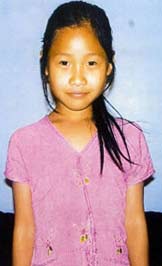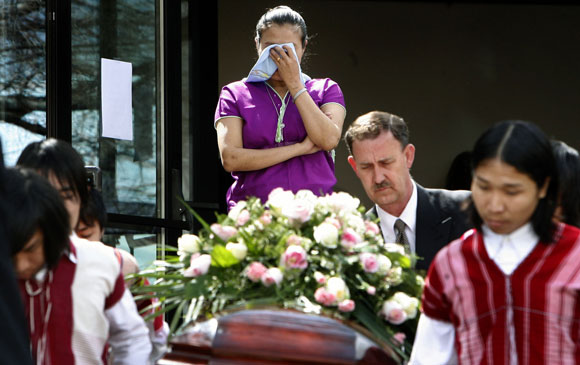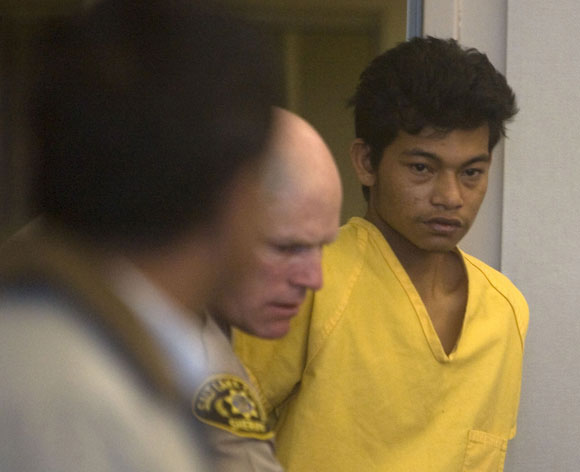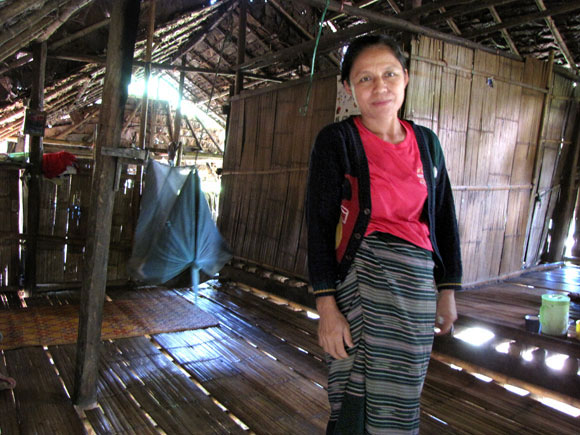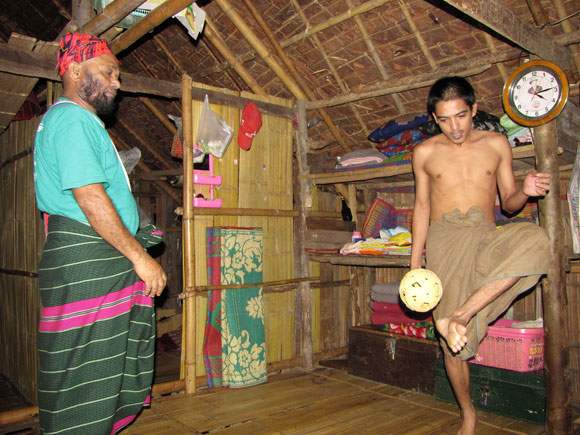
Stolen hope: Daughter's death comes after years of fear, running for a Burmese family
By Julia Lyon | The Salt Lake Tribune
March 31, 2008
She is probably dead before anyone reports her missing, still wearing her pink shirt, pink skirt and pink coat, lying face down in the shower where FBI agents would find her.
But everyone still expects 7-year-old Hser Ner Moo to reappear any minute -- eager to slip on her white dress-up shoes and play teacher with friends.
Four hours pass. Night falls.
The police arrive at South Parc, a shabby South Salt Lake apartment complex home to immigrants and refugees striving for more. As neighbors knock on doors, Hser Ner Moo’s mother clings to her newborn son, fearing it’s been too long.
Cartoon Wah is a slight man shaking at the microphone, begging for the return of his only daughter at a press conference the next day. The father wonders if someone is jealous of his precocious girl, the buddy who always rode on the back of his bike and kept him company in the kitchen as he cooked potatoes just hours before she vanished.
“We came from Burma where we had a lot of trials in our past life,” he says, his eyes welling with tears. “Then we come to America and it happens again.”
Friends drive his wife, Pearlly Wa, to the nearby ward house. In a small room, the mother kneels and prays. “I know she’s gone,” Pearlly tells them. “She’s with God.”
A few hours later, police unroll yellow crime tape outside a nearby apartment. FBI agents had discovered the second-grader beaten, raped and probably strangled, with short black hairs clenched in her right hand.
Officers arrest Esar Met, a Burmese refugee in his 20s, later that night. They promise the family justice. More than a year and a half later, Cartoon and Pearlly would still be waiting.
But in the hours after Hser Ner Moo’s death, it’s a minister, not a judge, they look to for peace.
Eight thousand miles away, on the edge of a jungle in Thailand, Pastor Arthur’s cell phone rings at Mae La refugee camp. Pearlly tells her pastor her inescapable conclusion: If they had not left Mae La for America last year, Hser Ner Moo would still be alive.
A simple refuge » Hser Ner Moo was born in candlelight at house No. 221, Section 5, Zone B of Mae La refugee camp. One more life quietly joined the thousands of Burmese families living in bamboo huts, packed tightly into the camp’s 1 1/2 gently rolling square miles.
Pronunciation guide
Hser Ner Moo: Soo-nah-moo
Cartoon Wah: Car-toon Wah
Pearlly Wa: Per-lee Wah
Esar Met: Ee-sahr Met
Ra He Mar: Rah-Hay-Mar
Mae La: May Lah
The newborn slipped through her father’s waiting arms onto the smooth bamboo floor. After three boys, they joyfully realized they finally had a girl.
Hser Ner Moo would never see Burma, now known as Myanmar, the country that had driven her parents and other ethnic Karen into exile. Pearlly’s father was forced to haul crippling loads of ammunition and food for the military until he escaped. Cartoon’s parents struggled to grow rice in a war zone before fleeing.
Both families walked for days to reach Thailand, where they settled at Baw Noh refugee camp and Pearlly drew Cartoon’s eye. They married in 1986 and had their first two sons.
But they hadn’t outrun the war. One morning in 1995, Cartoon, rice bag in hand, was about to pick up rations when he heard explosions.
As artillery shells rained down, he thought they would all be killed. He and Pearlly grabbed their naked sons from the nearby stream where they were bathing and took cover in a small gulch. They moved deeper into the forest at day’s end. By that time, fire had roared through the camp, destroying hundreds of huts.
An 18-year-old girl burned to death in the attack, by soldiers supporting Burma’s military government. Her screams seared into survivors’ memories.
Pearlly and Cartoon had never felt more frightened.
They hid with others who had fled, growing hungrier. Their cooking pots, their rice, everything they had was gone.
What is a refugee?
Unlike any other immigrant, a refugee is brought to this country by the U.S. State Department after being identified as someone fleeing his or her country because of persecution or a well-founded fear of persecution based upon race, religion, nationality, political opinion or membership in a particular group. An estimated 14 million people worldwide are classified as refugees, but only a small number are resettled each year. The U.S. resettles far more than any other nation, but those who come to America comprise less than 1 percent of all refugees.
A relief effort moved them and other survivors to Mae La refugee camp, about an hour from the nearest town. A paved highway dips and climbs past lush green rice fields until the camp suddenly emerges in a valley at the foot of limestone cliffs.
The parents built a two-room home in about a week, tying long bamboo stalks together and layering broad leaves as a roof to keep out the monsoon season’s drenching rains. Cartoon planted banana and tamarind trees.
Though another attack was always possible, Cartoon and Pearlly thought they would live at Mae La forever.
Each night, Hser Ner Moo curled up next to her parents and brother named Sunday Moo as they lay on woven mats on the main room’s floor. As they dreamed, crickets chirped their nightly hymn.
Roosters woke them in the mornings, as mist wrapped the steep hills above the camp. In the cool first hours of the day, store owners opened up shop on a muddy main street, sitting by wares from raw beef to frilly little girls’ dresses. The smell of frying bananas hung in the air.
Pearlly and Cartoon would wind sarongs around their waists, bursts of royal blue and scarlet amid the mud and bamboo. Pearlly smeared thanaka, a traditional cream-colored paste, on her young daughter’s cheeks.
As the hours passed, the heat intensified. They would retreat to the cool shadows inside their home, where sunlight pierced through gaps in the floor and walls. There was no electricity or running water.
Cartoon sometimes left home to work as an interpreter, translating Karen, Thai and Burmese. But he did not have enough money to buy Hser Ner Moo the bike she longed for, so she played with dolls under the watchful eyes of neighbors. Pearlly had a security job at the camp, reminding people not to drink or fight. There was no lock on their front door.
“A very young girl raped or murdered? We’ve never heard of such things,” she said.
A challenged son » About a mile away, people at Mae La knew Esar Met was not normal. He often sat alone, talking and laughing to himself in the Muslim section of the camp where his family lived. Or he played with children years younger, shooting rubber bands in the camp’s narrow lanes, flicking marbles across the rocky, dirt patches that were his neighbors’ yards.
He was the eldest of eight children, but when he argued with his younger brothers, he was the one to cry.
As a boy, he could not remember what he learned in class. His mother, Ra He Mar, knew her son was not very smart and worried he might become even slower as he grew older. After he had to repeat second grade, she let him drop out of school.
Friends told her the family should find someone to “check his brain,” but Esar's parents thought they couldn’t afford to have him tested.
Esar often wandered, forcing his mother to track him through a labyrinth of paths and homes rarely marked with names or numbers.
Once, overwhelmed by a breast-feeding baby and a sick husband, she led Esar away from the family’s porch to nearby laundry lines where she tied him to a pole.
As he grew older, Esar did not care about his looks and never had a girlfriend. He only changed his clothes when his mother told him to. He sometimes worked as a porter, using a basket on his back to deliver heavy loads of rice or other food to homes. He liked to use the money he earned to buy snacks for his friends.
“I’m happy playing with children,” he once told a cousin.
Esar’s jokes made people smile. When he watched Burmese comedies at a cafe or a friend’s house, he laughed with delight.
But he kept disappearing, one day announcing to his family that he wouldn’t come back unless they went to the United States.
Many of his friends had already left. Esar had heard refugees in America could earn money and enjoy a better life. His mother told him she didn’t want to go because she didn’t speak English, but Esar assured her they would learn.
Advance to the next chapter :: Return to the table of contents

 /a>
/a>


















 /a>
/a>















 /a>
/a>






